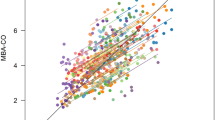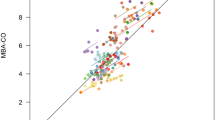Abstract
We aimed to describe and evaluate an autocalibrating algorithm for determination of cardiac output (CO) based on the analysis of an arterial pressure (AP) waveform recorded using radial artery applanation tonometry (AT) in a continuous non-invasive manner. To exemplarily describe and evaluate the CO algorithm, we deliberately selected 22 intensive care unit patients with impeccable AP waveforms from a database including AP data obtained with AT (T-Line system; Tensys Medical Inc.). When recording AP data for this prospectively maintained database, we had simultaneously noted CO measurements obtained from just calibrated pulse contour analysis (PiCCO system; Pulsion Medical Systems) every minute. We applied the autocalibrating CO algorithm to the AT-derived AP waveforms and noted the computed CO values every minute during a total of 15 min of data recording per patient (3 × 5-min intervals). These 330 AT-derived CO (AT-CO) values were then statistically compared to the corresponding pulse contour CO (PC-CO) values. Mean ± standard deviation for PC-CO and AT-CO was 7.0 ± 2.0 and 6.9 ± 2.1 L/min, respectively. The coefficient of variation for PC-CO and AT-CO was 0.280 and 0.299, respectively. Bland–Altman analysis demonstrated a bias of +0.1 L/min (standard deviation 0.8 L/min; 95 % limits of agreement −1.5 to 1.7 L/min, percentage error 23 %). CO can be computed based on the analysis of the AP waveform recorded with AT. In the selected patients included in this pilot analysis, a percentage error of 23 % indicates clinically acceptable agreement between AT-CO and PC-CO.


Similar content being viewed by others
References
Rajaram SS, Desai NK, Kalra A, Gajera M, Cavanaugh SK, Brampton W, Young D, Harvey S, Rowan K. Pulmonary artery catheters for adult patients in intensive care. Cochrane Database Syst Rev. 2013;2:CD003408.
Marik PE. Noninvasive cardiac output monitors: a state-of the-art review. J Cardiothorac Vasc Anesth. 2013;27:121–34.
Broch O, Renner J, Gruenewald M, Meybohm P, Schottler J, Caliebe A, Steinfath M, Malbrain M, Bein B. A comparison of the Nexfin(R) and transcardiopulmonary thermodilution to estimate cardiac output during coronary artery surgery. Anaesthesia. 2012;67:377–83.
Janelle GM, Gravenstein N. An accuracy evaluation of the T-Line Tensymeter (continuous noninvasive blood pressure management device) versus conventional invasive radial artery monitoring in surgical patients. Anesth Analg. 2006;102:484–90.
Szmuk P, Pivalizza E, Warters RD, Ezri T, Gebhard R. An evaluation of the T-Line Tensymeter continuous noninvasive blood pressure device during induced hypotension. Anaesthesia. 2008;63:307–12.
Dueck R, Goedje O, Clopton P. Noninvasive continuous beat-to-beat radial artery pressure via TL-200 applanation tonometry. J Clin Monit Comput. 2012;26:75–83.
Saugel B, Fassio F, Hapfelmeier A, Meidert AS, Schmid RM, Huber W. The T-Line TL-200 system for continuous non-invasive blood pressure measurement in medical intensive care unit patients. Intensive Care Med. 2012;38:1471–7.
Saugel B, Meidert AS, Hapfelmeier A, Eyer F, Schmid RM, Huber W (2013) Non-invasive continuous arterial pressure measurement based on radial artery tonometry in the intensive care unit: a method comparison study using the T-Line TL-200pro device. Br J Anaesth. 2013;111:185–90.
Bland JM, Altman DG. Agreement between methods of measurement with multiple observations per individual. J Biopharm Stat. 2007;17:571–82.
Critchley LA, Critchley JA. A meta-analysis of studies using bias and precision statistics to compare cardiac output measurement techniques. J Clin Monit Comput. 1999;15:85–91.
Alhashemi JA, Cecconi M, Hofer CK. Cardiac output monitoring: an integrative perspective. Crit Care. 2011;15:214.
Pugsley J, Lerner AB. Cardiac output monitoring: is there a gold standard and how do the newer technologies compare? Semin Cardiothorac Vasc Anesth. 2010;14:274–82.
Hamzaoui O, Monnet X, Richard C, Osman D, Chemla D, Teboul JL. Effects of changes in vascular tone on the agreement between pulse contour and transpulmonary thermodilution cardiac output measurements within an up to 6-hour calibration-free period. Crit Care Med. 2008;36:434–40.
Acknowledgments
Tensys Medical Inc. (San Diego, CA, USA) provided the technical equipment for this study.
Conflict of interest
BS and ASM received research grants from Tensys Medical Inc. (San Diego, CA, USA). BS and WH collaborate with Pulsion Medical Systems (Feldkirchen, Germany) as members of the medical advisory board. OG consults for Tensys Medical Inc. as medical advisor. For all other authors there is no conflict of interest to disclose. Funding: Tensys Medical Inc. (San Diego, CA, USA) provided the technical equipment for this study.
Author information
Authors and Affiliations
Corresponding author
Additional information
Bernd Saugel and Agnes S. Meidert have contributed equally to the study.
Rights and permissions
About this article
Cite this article
Saugel, B., Meidert, A.S., Langwieser, N. et al. An autocalibrating algorithm for non-invasive cardiac output determination based on the analysis of an arterial pressure waveform recorded with radial artery applanation tonometry: a proof of concept pilot analysis. J Clin Monit Comput 28, 357–362 (2014). https://doi.org/10.1007/s10877-013-9540-8
Received:
Accepted:
Published:
Issue Date:
DOI: https://doi.org/10.1007/s10877-013-9540-8




